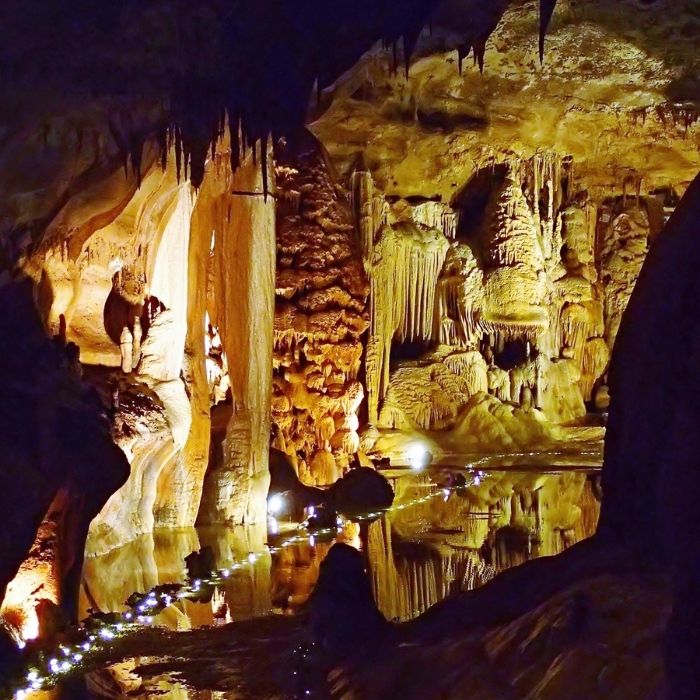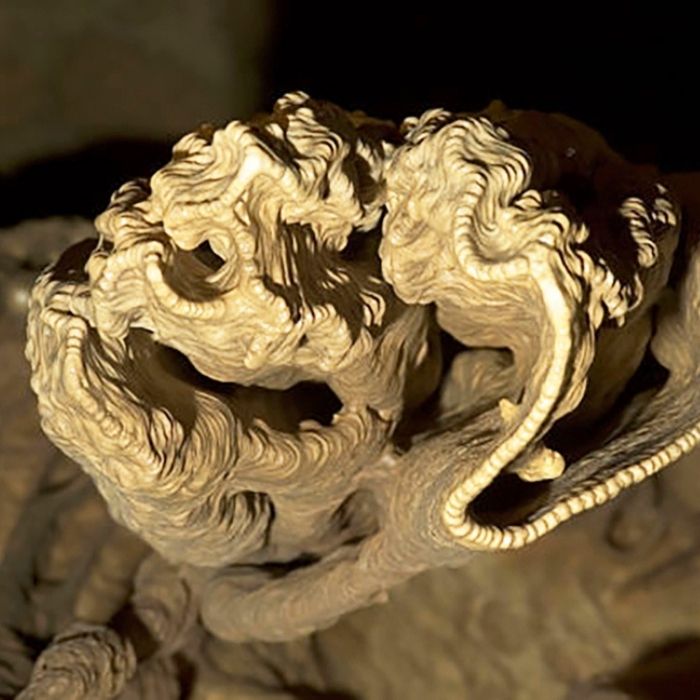WINTER 2025
Cave Without a Name
One fellow traveler enters the underworld of grief and returns renewed.
- Story by Anne Gisleson

Photo Credit: Tom Summers
JUST NORTH OF San Antonio, in Texas Hill Country, there’s a Cave Without a Name. I came across it one insomniac night while planning my solo escape to West Texas. Every year, I head to a desert town where I know no one to do nothing but read and write and walk the mostly empty scorching sidewalks. Cave Without a Name, a privately owned “show cave,” opened in 1939, a few years after its main chambers were reportedly “discovered” and explored by three adventurous children. In 1940 there was a state-wide contest to give a title to the cavern, and a young boy proclaimed it “too beautiful to have a name.” That wise, wise child, preserver of mystery, won a $50 cash prize.
Though I’d started these monastic West Texas trips during the mind-wrecking pandemic, I was once again feeling an urgent need for a getaway, an affirming mission. Over the previous twelve months I’d been to seven funerals, all but two for people younger than me. Two car accidents, two suicides, two incursions of the heart, and a protracted case of Alzheimer’s. Three were students I’d taught as high schoolers, one of them just months before they died. Shock and sorrow overlapped in deepening waves. I alternated between two black dresses for the services.
When I read that the The Texas Cellos orchestra would be performing a concert deep in the Cave Without a Name, something stirred beneath all those layers of grief. I watched a promotional video for the orchestra. Done in moody black and white, it showed twelve Texas Cellos playing “La Vie En Rose” in a spare, light-strewn warehouse. My heart swooned. Tears soaked my pillow.
As a child, at the symphony with my grandmother, I was captivated and a little embarrassed by a certain cellist, the brashness of her wide legged stance, the intense and intimate embrace of the curved body between her parted skirt. I didn’t know much about classical music, still don’t, but the cello’s range of expression, from high to low registers, seemed to suggest a special connection to both the pleasure and the hurt of the world. Even now, a cello gets me every time, in all of the important places.
My husband agreed to the eight-hour drive from our home in New Orleans, a weekend jaunt on the far end of feasible. Weeks later, after that crushing highway haul and a couple of stabilizing beers, we finally stood at the cave’s entrance among the canted mesquites and a crowd of about 200 people that snaked behind us through the parking lot. How would we all fit down there? The entrance resembled the above-ground tombs back home in New Orleans, and a few vultures were wheeling above us. Entering the cave wasn’t quite like death, but there was something of a reverse-birth to our descent.
The walls were slick and with every step down the narrow concrete staircase, I wanted to run my hands along their dripping contours. With the crowd now funneled underground, people below me, people above, it occurred to me, a little queasily, that there was no going back, only down. The metal handrails were hung with Edison bulbs on patio string lights, and red translucent Tupperware lids were placed behind them to shield the living walls from the bulbs’ heat. Show caves, both privately and publicly “owned,” have been around for centuries—from China to Slovenia to the US—and improvised lighting, like torches or carbide lamps or trippy lasers, has always been an essential part of the cave show.
Since we were near the front of the line, we were some of the first on that tentative, titillating descent to reach the chamber where concerts are held: the Queen’s Throne Room. It’s hard to describe the majesty of this limestone solutional cavern. It was larger than I expected, with calcium carbonate formations crafted by millennia that managed to be both ethereal and monstrously fleshy. There were flowstones and soda straws, stalactites and stalagmites. There were swaths of striated drapery called “cave bacon.” It was extraordinary, and I wanted to find the perfect seat.
Rows of cheap white plastic chairs fronted a raised concrete stage. LED rope lights lined the base of the walls. I wanted to go as deep into the Queen’s Throne Room as possible, past all the formations, where there would be nothing and no one between us and a glowing, milky subterranean pool of water that looked like something out of a fantasy novel. Eternal youth was tendered here. Strange visions proffered.
I stood up almost as soon as I sat down. My jeans were soaked.
“Oh, I was going to warn you,” a woman in front of me said.
“What is it?” I wiped my hand across the seat. “Cave piss,” she replied.

A subterranean pool reflects the formations around it. Photo Credit: Tom Summers

A geographic formation seen in the cave. Photo Credit: Tom Summers and Gary Bordeaux
There were no programs, no words to connect with anything, no rustling xeroxed list of musicians and song titles and composers to anticipate or reference. Just the whispery hush of a waiting congregation, awed by the spectacle of the cave. The orchestra filed out from an adjacent cavern—one of the many cordoned off for the evening to keep concertgoers from wandering off. Many of the musicians appeared to be from the Texas Cello Youth Orchestra. They were in their mid to late teens, and their fresh faces at odds with their funereal attire. Leading them was a Europeanly handsome conductor named Joseph Kuipers. He had thick, wavy brown hair and announced that we would be starting with a selection from Giovanni Sollima, the “rock star” composer for the cello. The first spare, anticipatory notes of “Hell I,” inspired by Dante’s Inferno, startled with their intensity and clarity, magnified by acoustics that no human could engineer. The sound seemed to come at us from all sides, from the past itself.
Kuipers guided the young cello orchestra through a range of musical genres, swinging from pop to austerely classical, all elevated and unified by the dreamy precision of the cello. Whether Elvis or Arvo Part, Mancini or Satie, Schubert’s communion hymn or The Game of Thrones themes, the cellos gave everything depth, the cave gave everything blessed mineral coherence. Emotions I didn’t even try to sort out surged to the surface of my skin and I clutched my husband’s hand, overwhelmed. The humidity, the music, the smell of bodies in trapped air. The glistening domes of the three bald men in successive rows before me became as much geological features as the stalagmites.
In Night Vision: Seeing Ourselves through Dark Moods, a book about reframing grief, anger, and anxiety, philosopher Mariana Alessandri repeatedly invokes the comfort of the cave as a relief from the glare of the Light Metaphor peddled by everyone from Plato to self-help authors. Light famously signifies knowledge and happiness, and darkness, on the other hand, ignorance and despair. “After all,” Alessandri writes,“most people have only ever learned to run away from a cave of grief, not how to enter it, sit in the dark, and hold space for dolor.” I love the double meaning of “night vision”—that we can be meaningfully reflected back to ourselves through these “dark moods” and also that we can be our own Virgils, guiding ourselves through them, if only we pay attention to the darkness and don’t immediately reach for the facile myth of the Light Metaphor. In Alessandri’s caves, “there’s a lot of silence, the silence of listening, feeling, and thinking.” The Queen’s Throne Room, on the other hand, was rigged with LEDs and swelling with centuries of music, both sacred and secular. My year of roiling grief must’ve somehow magnetized me to this cave experience, to the instrument that seemed uniquely suited to articulating grief and hope: the cello.
In introducing the theme from Titanic, Kuipers asked the audience to remain silent between songs, not to clap, and the audience obeyed, creating a particular and powerful silence. The silence birthed “Nearer My God to Thee,” the song that, according to myth, the band played as the Titanic tilted into the icy north Atlantic. I succumbed to the set-up. Let unwiped tears glaze my face. Something about the pained strain of concentration on the face of one of the youngest cellists. Something about doomed youth (all youth is doomed), evoking the elaborately doomed ship.
Kuipers did not announce the title of the concert’s finale. A Finale Without a Name. He said we all knew it, and we did, the swelling melancholy strains of the song once deemed overplayed even by its creator, Leonard Cohen, forever redeemed in my mind, ears, and heart. “Hallelujah.” We had descended in order to transcend. Cave tears from above dropped onto my sleeve, not from loss this time but from abundance.
The departing crowd’s wake left the plastic chairs in disarray. To disguise our lingering, we helped the staff stack them. We didn’t want to leave. Later, my husband and I would both report a strong desire to lie down during the concert, next to the milky pond in the womb of the Queen’s Throne Room, and spend the night there.
Back on the highway the next morning, Lady Bird Johnson’s famous wildflowers, her bluebonnets and golden wave and Mexican blankets, escorted us to the state line, in unbroken miles of spring technicolor. Many, many hours later, we re-entered New Orleans, the I-10 flanked by cemeteries, those famed cities of the dead.
The night before, after the concert, when we emerged from the cave’s entrance, from the same architecture as these tombs, I swear I felt born. Under the stars on the hill with the mesquites, the transformed crowd spread through the parking lot, headlights processing into the night, into the shining dark, filled with possibility. And on that winding, unlit road back to town, I thought about how so much was possible—that late night anxiety and grief could lead you from your bed to a spectacular pocket of life, that your partner could agree to drive with you all weekend, on his days off. That you could enter the underworld and return, renewed.
ANNE GISLESON is the author of The Futilitarians: Our Year of Thinking, Drinking, Grieving and Reading (Little, Brown). She lives in New Orleans.